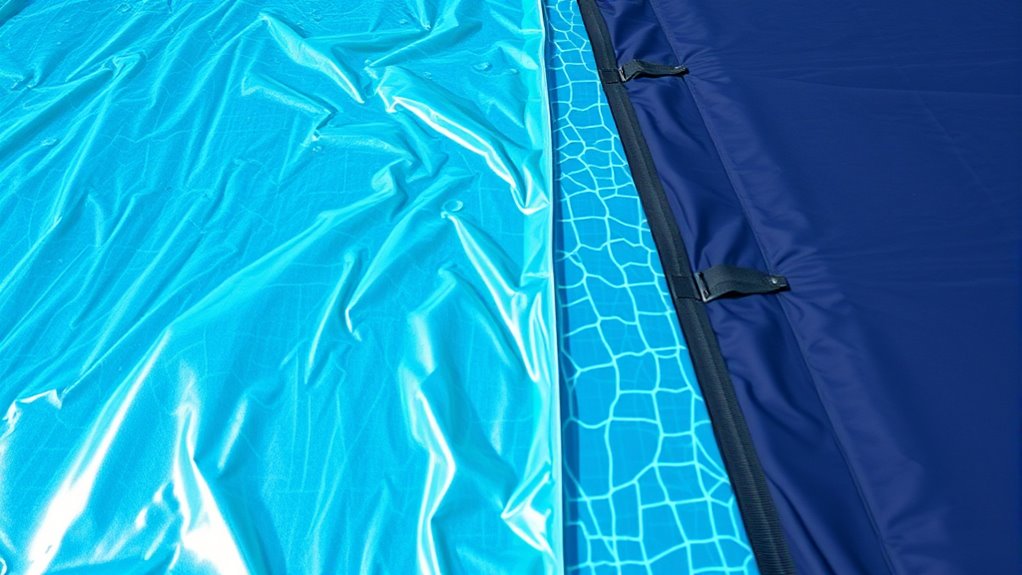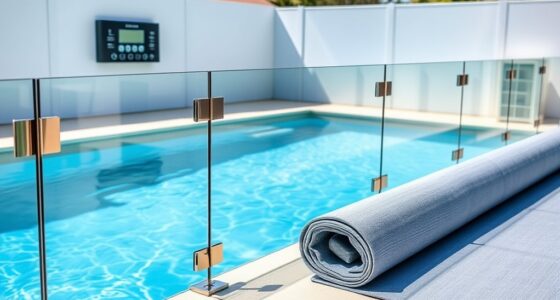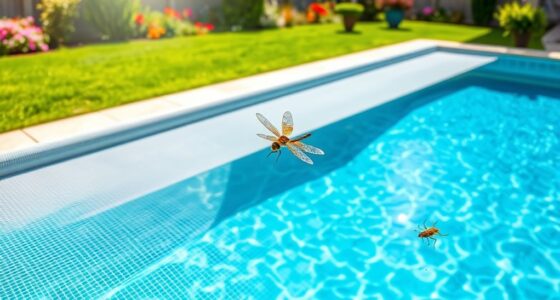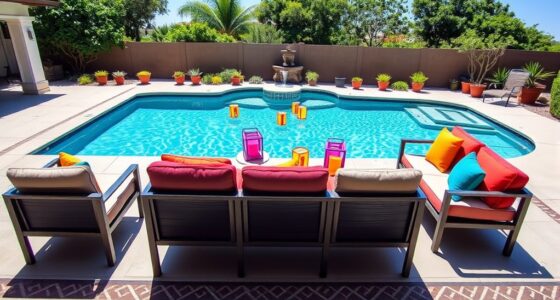Solar covers are thin, bubble-like plastics that float on your pool’s surface to trap heat, reduce evaporation, and keep debris out. Safety covers are thicker, robust materials designed to support weight and prevent accidental falls, often installed with anchors for year-round security. They differ in durability, cost, and purpose—solar covers focus on energy savings, while safety covers prioritize safety. To understand which suits your needs best, explore further details below.
Key Takeaways
- Solar covers are thin polyethylene films that trap heat and reduce evaporation, while safety covers are heavy-duty, load-supporting materials for security.
- Solar covers float on water and are removable seasonally; safety covers are anchored permanently for year-round safety.
- Solar covers are more affordable and have a lifespan of 3-7 years; safety covers are costlier, lasting up to 15 years with proper care.
- Safety covers meet ASTM F1346 standards, supporting at least 485 lbs, whereas solar covers do not provide safety or support features.
- Installation of solar covers is simple and DIY-friendly; safety covers often require professional installation and secure anchoring.
Material Composition and Construction Features
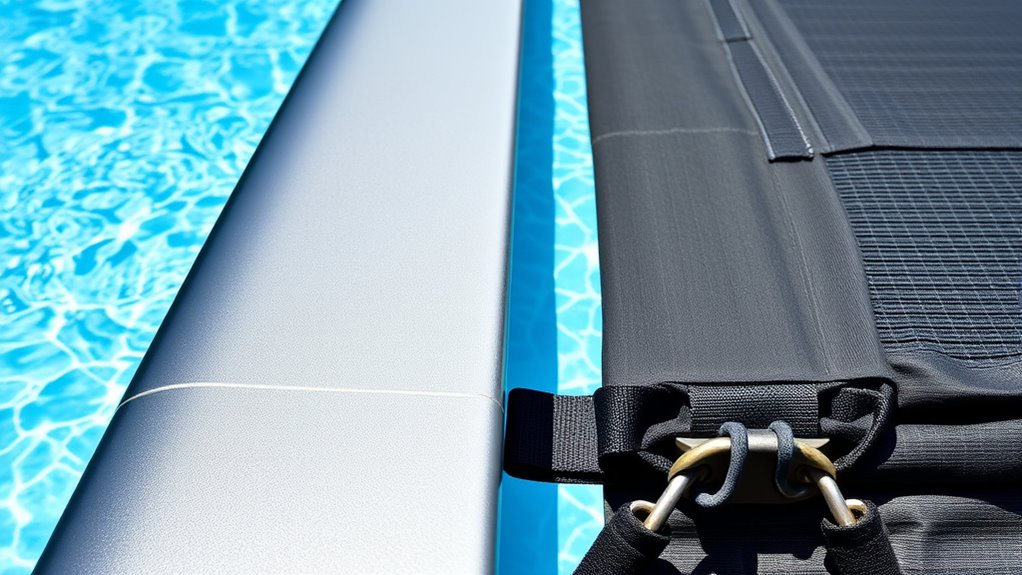
Understanding the material composition and construction features of solar covers is essential for choosing the right one for your pool. Solar covers mainly use polyethylene film as their base, with air-filled bubbles that provide insulation. These bubbles come in round or diamond shapes, each offering different heat transfer and water runoff benefits. Thickness options range from 400 to 500 microns, with thicker versions offering enhanced UV protection and durability. Some covers include a reinforced fiber weave overlay, increasing strength and lifespan. The top layer may feature UV stabilization to prevent degradation. Construction features like air pockets float on the water, transferring solar heat and reducing heat loss overnight. Additionally, the bubble shape influences how effectively the cover insulates and sheds water, making it an important consideration when selecting a cover. Color options, such as blue or clear, optimize heat absorption, while modular rings allow partial coverage, offering versatile solutions for your pool.
Core Functions and Safety Aspects

Understanding the core functions and safety aspects of pool covers helps you choose the right option for your needs. While solar covers excel at heat retention and reducing evaporation, they don’t provide safety support. Conversely, safety covers are built for security and accident prevention but lack the thermal benefits of solar covers. Additionally, safety covers are typically made of stronger, more durable materials to withstand weight and prevent accidental falls into the pool. Incorporating pool safety features can further enhance protection and peace of mind for pool owners.
Safety Capabilities and Limitations
Safety covers are designed to provide a reliable physical barrier that prevents children and pets from falling into the pool, substantially reducing drowning risks when properly installed. Unlike solar covers, safety covers are engineered to support weight, with standards supporting at least 485 lbs, and high-quality options supporting up to 2000 lbs. They feature strong attachment systems that keep them securely in place. Additionally, material strength plays a crucial role in their durability and effectiveness. However, safety covers have limitations: they are heavy and can be difficult to handle, and if not maintained, their strength can diminish over time. While they effectively block access, they don’t prevent entrapment or trapping of limbs, especially if the cover isn’t properly secured or in poor condition. Regular inspection and correct installation are essential for ensuring their safety benefits. Proper maintenance and inspection are crucial to ensure safety cover integrity over time.
Thermal and Debris Control
Thermal and debris control are essential functions of pool covers that help maintain water quality and conserve energy. Solar covers absorb sunlight, converting it into heat that warms your pool while trapping warm air and water to reduce heat loss. They can raise water temperatures by 10-15°F on sunny days, cutting energy costs. These covers also act as physical barriers, preventing leaves, dirt, insects, and debris from entering the water, which lowers cleaning and chemical treatment needs. Additionally, they notably reduce evaporative heat loss—up to 95%—by blocking water vapor, especially in windy or hot climates. The effectiveness depends on material properties like solar absorptivity and low emissivity, which help retain heat and improve overall thermal efficiency. Proper handling of the covers ensures optimal performance and longevity, further enhancing their thermal and debris control benefits, especially when combined with tuning techniques that optimize energy efficiency in related systems.
Installation Methods and Ease of Use
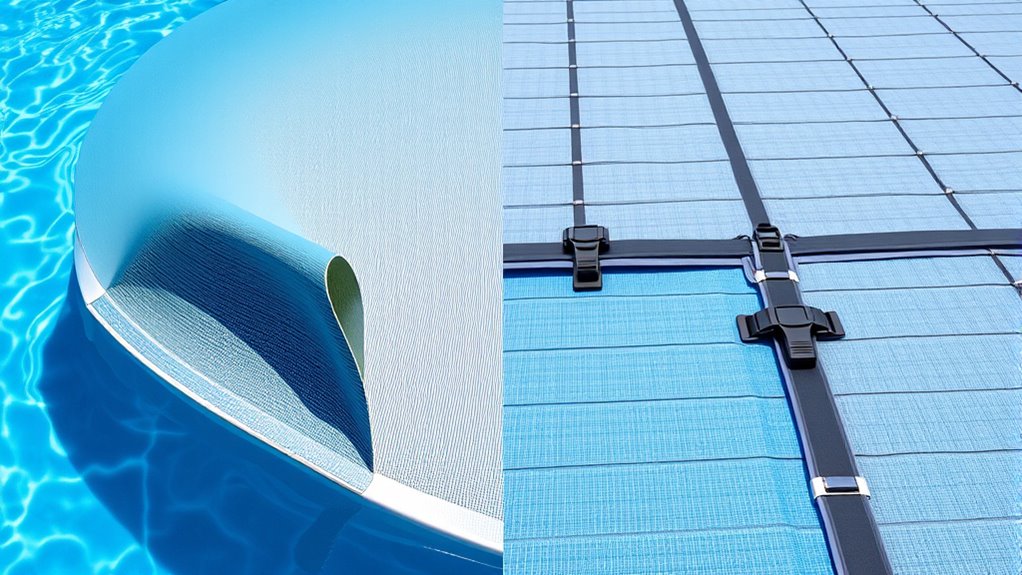
Installing solar covers is straightforward since they float directly on the pool surface and require no fixing to the deck. You simply unroll the cover over your pool with the bubble side facing down, and it stays in place naturally. Handling is easier with thinner covers, which are lighter and simpler to manage, especially when using a reel system. Thicker covers provide better insulation but can be heavier to handle manually. You don’t need professional help, as installation is a DIY process, and no anchors or hardware are necessary. The lightweight design and quick placement make solar covers user-friendly. In contrast, safety covers involve measuring, securing anchors, and sometimes professional installation, making them more complex and time-consuming to set up and remove. Understanding installation methods helps you choose the right cover for your needs and ensures safe, effective use.
Durability and Expected Lifespan
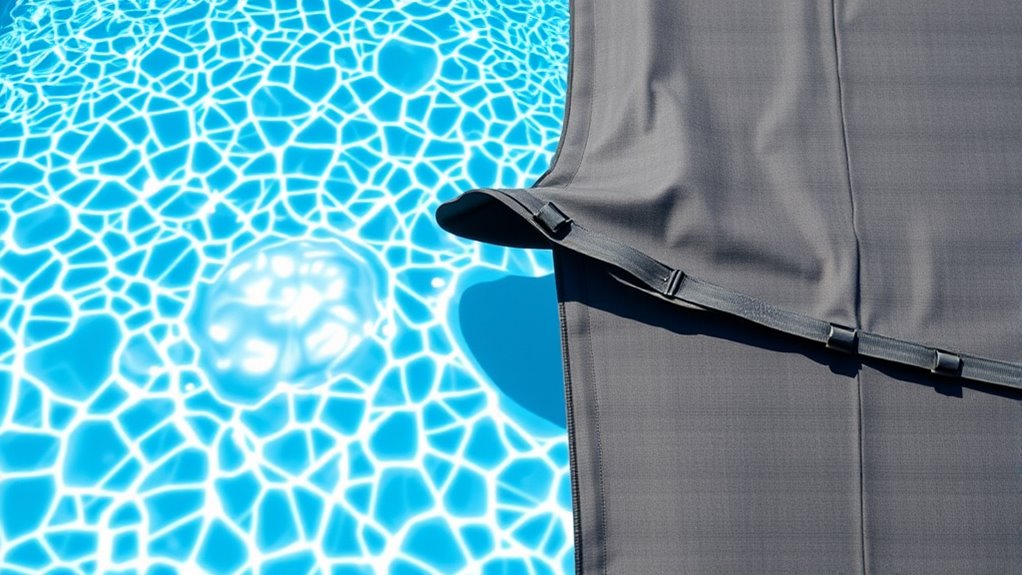
When considering durability, safety covers are built from reinforced vinyl or heavy-duty mesh that can withstand harsh weather and physical stress. They typically last 10 to 15 years with proper maintenance, though their lifespan can be shortened by extreme conditions or neglect. Proper storage can help extend the lifespan of solar covers, preventing unnecessary damage when not in use. Additionally, solar covers are more susceptible to material wear, which can be accelerated by exposure to UV rays and environmental factors.
Material Strength and Resilience
Material strength and resilience play a crucial role in determining how long your solar and safety covers will last and how well they withstand harsh conditions. Solar covers are usually made from polyethylene with air-filled bubbles, with thicker versions (12-16 mil) resisting sun damage and tearing better. Safety covers feature premium polypropylene mesh or solid polyethylene, designed for high tensile strength and UV resistance. Mesh safety covers use a specialized blend that permits water flow and withstands UV exposure, while solid covers create an impermeable barrier, handling heavy rain and debris. Hybrid safety covers combine both materials for durability and balance. These materials meet ASTM standards for safety and load capacity, ensuring they remain durable under seasonal weather changes and demanding environments. Advanced manufacturing techniques contribute to improved longevity and performance of these covers, making them suitable for various climates and usage requirements. Additionally, selecting appropriate materials enhances the overall effectiveness and lifespan of your covers.
Longevity and Maintenance Needs
The durability of your pool covers depends heavily on the materials used and how well they’re maintained over time. High-quality safety covers typically last between 7 and 15 years, with mesh covers often reaching 12 to 15 years, thanks to their resistance to UV damage and tearing. Solid safety covers tend to last around 10 years. Environmental exposure from sun, wind, rain, and chemicals gradually wears them down, but proper care extends their lifespan. Regular inspections, prompt repairs, and storing covers away from sunlight help prevent deterioration. Using cover reels minimizes handling damage, while keeping debris clean prolongs performance. For solar covers, thicker materials last longer, but exposure to sunlight and chemicals accelerates aging. Proper maintenance and seasonal storage are essential for maximizing lifespan. Incorporating professional equipment and following manufacturer guidelines can further enhance the longevity of your covers.
Cost Differences and Budget Considerations

Choosing between solar covers and safety covers depends heavily on your budget and priorities. Solar covers range from about $30 to $1,000, with above-ground options being especially affordable, while inground versions cost up to $1,000. Safety covers, like mesh or vinyl types, usually cost between $1,200 and $3,000, with automatic covers soaring above $10,000. Installation costs for solar covers are moderate, often totaling around $1,000, whereas safety covers involve complex installation and higher initial expenses. Durability also varies; solar covers last 3 to 7 years, while safety covers can last up to 15 years, but at higher upfront costs. If saving money is a priority, solar covers are more budget-friendly, but safety covers offer long-term safety and durability. The choice of cover can significantly impact your pool maintenance routine and safety measures over the years. Additionally, cultural and regional differences in pool usage and climate can influence the most suitable type of cover for your needs.
Compliance With Industry Standards
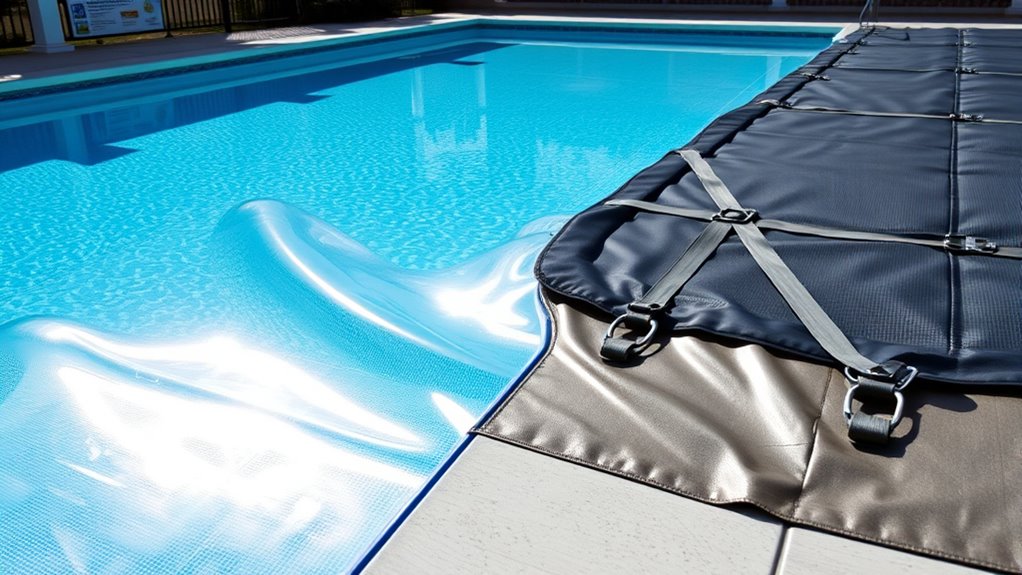
Understanding industry standards for pool covers is essential for ensuring safety and legal compliance. Safety covers must meet ASTM F1346, which specifies design and performance requirements, such as supporting at least 485 pounds to prevent accidental drownings. These covers include mesh, solid, and hybrid types, tested for load capacity, UV resistance, and chemical durability. In contrast, solar covers generally don’t meet safety standards because they aren’t designed to support weight or serve as barriers. Key differences include:
Safety covers meet ASTM F1346 standards, supporting heavy loads and ensuring pool safety.
- Safety covers adhere to ASTM F1346, supporting heavy loads
- Solar covers use polyethylene film, not tested for safety
- Automatic safety covers feature locking mechanisms and flood resistance
- Heavy-duty materials like reinforced vinyl ensure durability
- Safety covers include edge reinforcements and anchoring systems
This compliance guarantees safety, legal adherence, and peace of mind. Proper testing and certification ensure that safety covers meet necessary standards for reliable protection, and understanding industry standards can help consumers make informed decisions.
Typical Usage Scenarios and Seasonal Applications
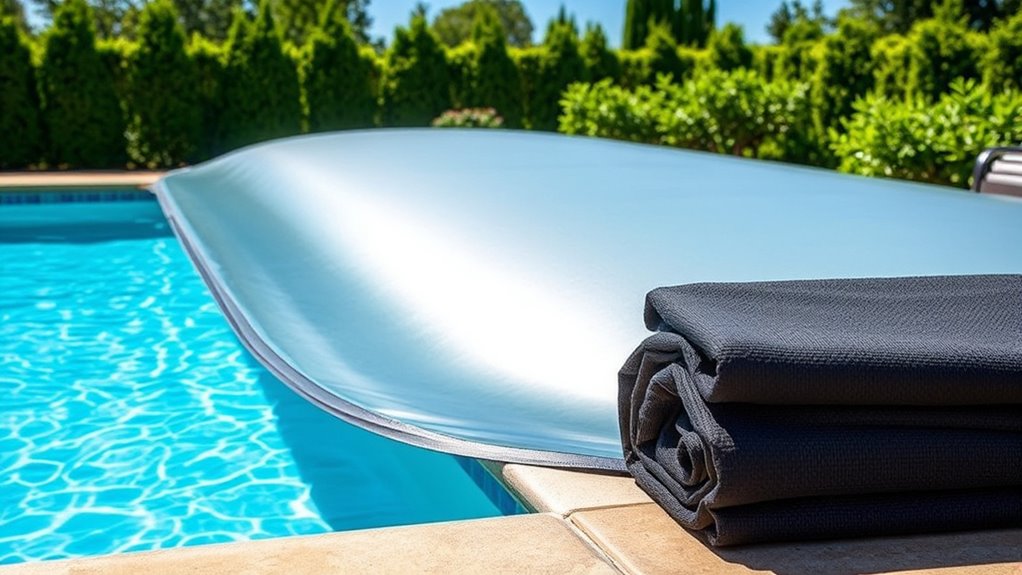
Solar covers are primarily used during the warmer months to maximize energy efficiency and water conservation. You place them on your pool to trap solar heat, helping warm the water naturally and reducing your reliance on electric or gas heaters. They also act as a barrier against evaporation and chemical loss, making your pool more sustainable. Typically, you use solar covers from spring through fall when water heating and water retention are priorities. You often remove or roll them up during colder months or storms when pool use drops. These covers are ideal for extending your swimming season and lowering energy costs, but they aren’t intended for safety. They don’t support weight and shouldn’t be used to prevent accidental falls or secure the pool during off-seasons. Because they lack safety features, they should never be considered a substitute for safety covers or barriers. Additionally, understanding pool safety guidelines ensures proper protection and accident prevention.
Impact on Pool Maintenance and Energy Efficiency
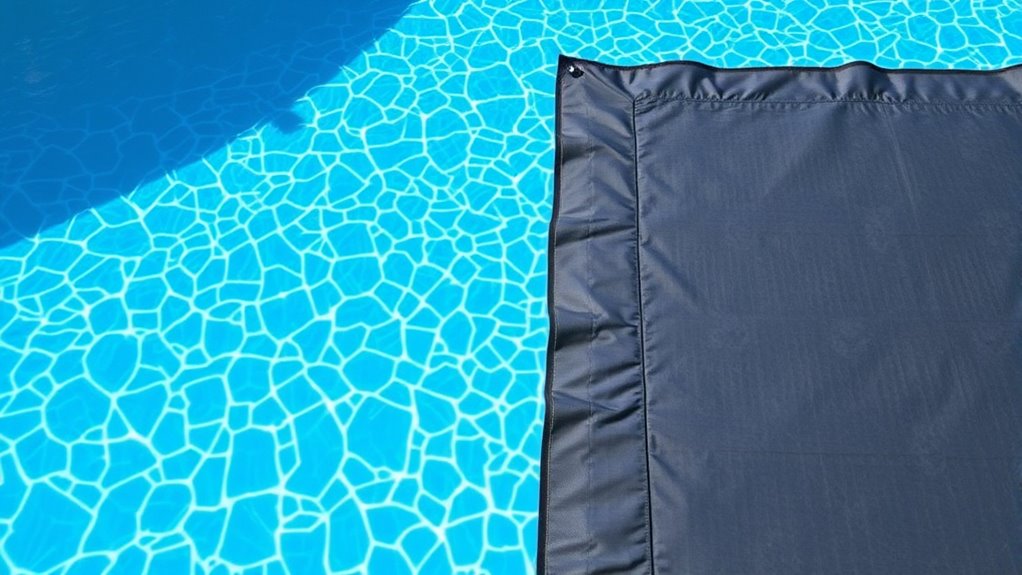
Solar covers substantially reduce water evaporation, often by up to 95%, which helps conserve water and lowers the need for frequent chemical additions. This reduction minimizes heat loss, decreasing energy needed to maintain your pool’s temperature. With less evaporation, chemical levels stay more stable, reducing the frequency and cost of chemical treatments. Safety covers, however, offer minimal evaporation control and focus mainly on safety. They may require different chemical adjustments due to water chemistry changes caused by rain or debris. To envision this:
Solar covers drastically cut water loss, saving resources and reducing chemical costs.
- Solar covers trap heat, extending swim seasons
- Reduced evaporation cuts chemical costs
- Safety covers primarily enhance safety, not water conservation
- Regular cleaning of solar covers prevents algae buildup
- Safety covers need inspections for durability and safety
- Proper maintenance of solar covers ensures optimal performance and longevity
Frequently Asked Questions
Can Solar Covers Be Used as a Safety Barrier?
No, solar covers cannot be used as safety barriers. They’re lightweight, made of floating plastic, and lack the strength to support weight or prevent falls. If someone steps on it, it’ll give way, risking injury or drowning. For safety, rely solely on certified safety covers or fences, which are designed to hold weight and provide a secure barrier, ensuring everyone’s safety around your pool.
Are Safety Covers Suitable for All Pool Types?
Safety covers are suitable for most pool types, but don’t assume they’ll fit every shape or setup perfectly. You’ll need the right anchoring points, adequate surrounding decking, and sometimes custom solutions for irregular or unusual pools. For inground pools, installation’s straightforward, but above-ground pools often pose challenges. So, while safety covers work for many pools, in some cases, you’ll need tailored options to guarantee complete safety and proper fit.
How Do Safety Covers Affect Pool Accessibility During Winter?
Safety covers make your pool inaccessible during winter by creating a strong physical barrier. They’re anchored securely around the pool’s perimeter, so you can’t enter or use the water without removing them. This restricts access for safety reasons, especially to prevent accidents involving children or pets. When installed properly, they stay taut and secure, ensuring that only authorized individuals can remove them, maintaining safety and control throughout the colder months.
Can Solar Covers Prevent Algae Growth Effectively?
Yes, solar covers can effectively prevent algae growth if used properly. They block sunlight, depriving algae of the energy needed for photosynthesis, and reduce debris entry, limiting nutrients. However, you’ll need to maintain proper chemical levels, especially chlorine, and guarantee good circulation. Regular cleaning and choosing specialized covers with algae-inhibiting features enhance prevention. Combining these practices helps keep your pool algae-free and clean throughout the season.
Do Automatic Safety Covers Require Special Maintenance?
Did you know that improper maintenance can reduce an automatic safety cover’s lifespan by up to 30%? You’ll need to clean the cover regularly with gentle methods, inspect tracks for debris, and make sure the mechanical parts are lubricated by professionals. Routine checks for tears or wear are essential, and annual or biannual professional inspections help keep your cover operating safely and efficiently, extending its lifespan and protecting your pool.
Conclusion
Choosing between solar covers and safety covers depends on your needs. For example, if you want to save energy and keep your pool warm, a solar cover is ideal. But if safety is your top priority, especially with kids or pets, a safety cover provides peace of mind. Assess your budget, usage, and safety concerns to pick the right option. Ultimately, the right cover helps you enjoy a safer, more efficient pool season.

